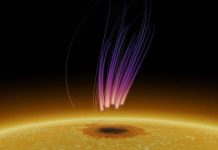New work suggests active tectonics on ancient Venus and that the tectonic state of the planets may change over time
A new study confirms that high levels of nitrogen and argon in Venus’s atmosphere indicate emissions of gases during tectonic activity billions of years ago. This suggestion could mean that Venus may have been habitable for a long period before some event that changed its conditions.
Scientists have long sought to understand why Venus’s carbon dioxide-rich atmosphere is 90 times denser than Earth’s and contains almost no water vapor, despite the planet’s temperature being maintained at 462 degrees Celsius. However, there is a possibility that such conditions were not always like this. Previous studies modeling Venus’s geological past have pointed to the possibility of a small ocean of liquid water and a habitable surface early in the first two billion years or so of the planet’s early history.

Scientists from Brown University used the underlying data to compare Venus’s current atmosphere with atmospheres created by a variety of models of long-term thermo-chemical-tectonic evolution. In other words, they tried to establish a correspondence between the current atmosphere of the planet and possible previous scenarios that take into account tectonic changes.
“Venus’s existing atmosphere requires gases to be ejected early in its life due to activity similar to plate tectonics. Our results indicate that the atmosphere of Venus is the result of a climate-tectonic transition that lasted at least a billion years, and then transitioned to the current regime of a virtually stationary “stagnant mantle” with reduced rates of gas emissions,” the scientific team notes in their paper. . The concept of a “stagnant mantle” (Stagnant lid) means that the surface of the planet consists of a single plate with limited mobility and gas release into the atmosphere.
The study of Venus has given rise to suggestions that planets can change their tectonic state and living conditions
The researchers simulated the events that had to happen on the planet for it to reach the state it is in now.
Scientists believe that Venus likely had active plate tectonics immediately after its formation, approximately 4.5 billion to 3.5 billion years ago. Based on the proposals in the paper, early tectonic movement, similar to that of the Earth, was limited by both the number of moving plates and the scale of their displacement. However, presumably, some events occurred on Venus that led to a stop in the tectonic movement of plates.
Because this work has the potential to change our current understanding of planetary evolution, additional testing of the model’s results is necessary.
“Up until now, we thought that plate tectonics was in a ‘binary state’: it either exists or it doesn’t. It either existed throughout the entire history of the planet or did not exist at all. In our work, we showed that planets can transition between different states of tectonics. “In addition, the results also indicate that there may be planets transitioning between habitable states and not just viable ones,” said study co-author Alexander Evans, assistant professor of earth, environmental and planetary sciences at Brown University.
In addition, this work points to the possibility of several ways to interpret the history of the planet.
“At the moment, we still adhere to the paradigm where we study their surfaces to understand the history of planets. But we have demonstrated that the atmosphere may be the best tool for understanding the ancient history of planets, which is often not preserved on their surface,” Evans said.
Future missions to Venus will help refine the data from this study. NASA’s DAVINCI (Deep Atmosphere Venus Investigation of Noble gases, Chemistry and Imaging) mission will provide measurements of gases in the atmosphere of Venus. In turn, the European Space Agency’s EnVision probe will probe the planet’s dense atmosphere from orbit using high-resolution radar. DAVINCI is scheduled to launch in 2029 and EnVision between 2035 and 2039.




